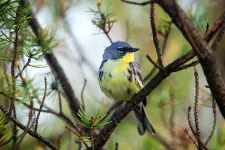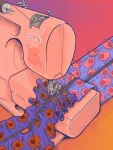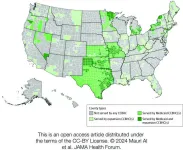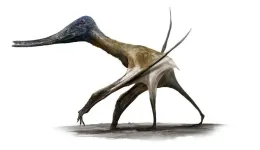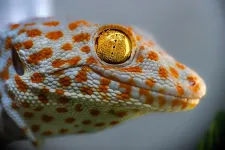While scientists have long known that the quality of winter, or non-breeding, habitat influences migratory birds’ migration timing and reproductive success, the study, published today in Current Biology, marks the first time researchers have linked winter conditions with migration survival. Analysis of the data for both the Kirtland’s warbler and the black-throated blue warbler revealed reduced rainfall and diminished vegetative productivity in the birds’ Caribbean non-breeding habitats resulted in fewer birds surviving spring migration. For Kirtland’s warblers, poor quality winter habitat also reduced survival in the subsequent breeding season.
As bird populations continue to decline, understanding the factors influencing their survival throughout the year is crucial. The Caribbean is expected to get drier in the coming decades due to climate change, suggesting migratory bird species such as these warblers could face even greater challenges going forward.
“If winter habitat quality continues to degrade over the next half-century due to climate change, we can now say that it will reduce birds’ ability to survive spring migration,” said Nathan Cooper, the study’s lead author and research ecologist at NZCBI. “That knowledge can help us prioritize conservation measures on the most drought-resistant non-breeding grounds.”
Beginning in 2017, Cooper and his co-authors wanted to investigate how environmental conditions on non-breeding grounds affect survival during spring migration and on the breeding grounds. However, GPS tags, which can track individual birds continuously, are too heavy to attach to most songbirds. Instead, songbird researchers must rely on other devices, like radio transmitters, which are lighter but only reveal their location when a receiver is within 6 to 10 miles. Many species breed over large swathes of North America, making it all but impossible to correctly guess where an individual bird might end up breeding with enough precision to detect its radio transmitter.
But Kirtland’s warblers offered Cooper and his co-authors a unique opportunity because nearly the entire population breeds in a relatively small part of Michigan. This made it possible to track down the same individual birds tagged in their non-breeding habitat in the Bahamas.
The team analyzed three years of radio tracking data from 136 tagged Kirtland’s warblers to estimate their survival rate across their migration and its relation to environmental factors.
In addition to directly estimating survival for Kirtland’s warblers, the team also indirectly estimated migratory survival rates for black-throated blue warblers using a statistical technique first developed by Scott Sillett, co-author of the study and NZCBI wildlife ecologist, in 2002. The researchers improved Sillett’s methods to analyze 14 years of capture-recapture data from the black-throated blue warbler’s New Hampshire breeding grounds and its non-breeding grounds in Jamaica, and then link survival to environmental conditions.
Despite the two different methodologies, both species showed lower survival rates during migration compared to stationary periods. The study also confirmed that poor winter habitat conditions, such as drought or reduced vegetative productivity, led to lower survival rates during spring migration and, in some cases, the subsequent breeding season. This is the first direct evidence of this type of carry-over effect on survival during migration. The approach facilitated by Kirtland’s warbler’s restricted breeding grounds allowed the team to validate the more indirect approach to estimating migration survival.
“To effectively conserve migratory birds, we need to pinpoint when and where in their annual cycle they’re under threat,” Cooper said. “Being able to reliably estimate survival during migration versus stationary periods is the first step towards figuring out when, where and how birds are dying throughout the year.”
But Cooper said it is critical to take a more holistic approach to effectively protect migratory bird species. For instance, it is unclear whether deaths during migration are the primary source of mortality or just one of many factors. Luckily, Cooper and co-authors Clark Rushing of the University of Georgia and Scott Yanco of the University of Michigan received a four-year grant from the U.S Fish and Wildlife Service’s Great Lakes Restoration Act to build full annual-cycle population models for Kirtland’s warblers. This model will help scientists determine how the dangers of migration fit into the broader picture for warblers, a strategy that could prove useful for the conservation of other declining migratory species.
About the Smithsonian’s National Zoo and Conservation Biology Institute
The Smithsonian’s National Zoo and Conservation Biology Institute (NZCBI) leads the Smithsonian’s global effort to save species, better understand ecosystems and train future generations of conservationists. Its two campuses are home to some of the world’s most critically endangered species. Always free of charge, the Zoo’s 163-acre park in the heart of Washington, D.C., features 2,200 animals representing 400 species and is a popular destination for children and families. At the Conservation Biology Institute’s 3,200-acre campus in Virginia, breeding and veterinary research on 264 animals representing 20 species provide critical data for the management of animals in human care and valuable insights for conservation of wild populations. NZCBI’s more than 300 staff and scientists work in Washington, D.C., Virginia and with partners at field sites across the United States and in more than 30 countries to save wildlife, collaborate with communities and conserve native habitats. NZCBI is a long-standing accredited member of the Association of Zoos and Aquariums.
About the Life on a Sustainable Planet Initiative
Life on a Sustainable Planet (LSP) is a vital initiative from the Smithsonian designed to advance and inspire global engagement in environmental stewardship. This comprehensive program applies the Smithsonian’s expertise in science, outreach and education to foster holistic approaches to preserving ecosystems, building resilience and educating the world about sustainable climate solutions. Smithsonian scientists partner with communities and organizations around the world, conducting research and educational programs to shape the future. LSP programs save and protect biodiversity, champion sustainable practices and offer innovative solutions to the challenges posed by our changing climate.
# # #
Photo Credit: Nathan W. Cooper, Smithsonian’s National Zoo and Conservation Biology Institute
Photo Caption: Researchers found drier winters impact the likelihood of Kirtland’s warblers surviving migration and their ability to survive the breeding season.
END
